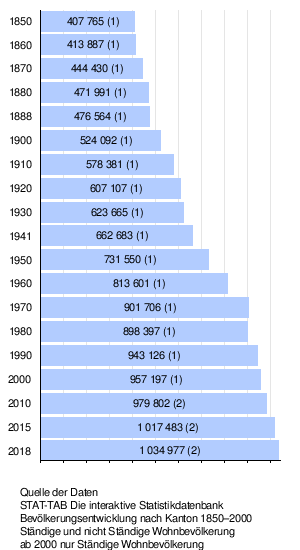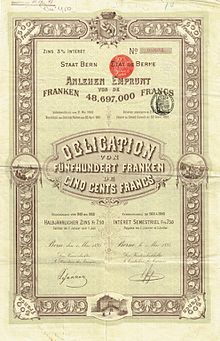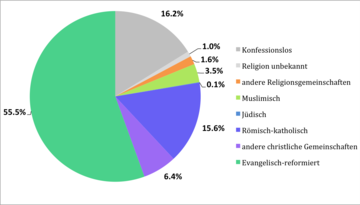Canton of Bern
46.87.6Coordinates: 46° 48′ N, 7° 36′ E; CH1903: 612319 / 183217
Population development

Bern (abbreviation BE; Bern German Bärn [b̥æːrn], French Berne, Italian Berna, Rhaeto-Romanic![]() ) is a canton in western Switzerland The capital and also the most populous place is the federal city of Bern.
) is a canton in western Switzerland The capital and also the most populous place is the federal city of Bern.
The border between German-speaking Switzerland and French-speaking Switzerland (Romandie), known as the "Röstigraben", runs through the canton of Bern. The Bernese national and official languages are German (86% of the population) and French (11%). French is spoken primarily in the Bernese Jura and in the Biel agglomeration, which has bilingual status.
The Canton of Berne is the second largest canton in Switzerland in terms of area (after Graubünden) and population (after Zurich).
Geography
The Canton of Berne has the largest north-south extension of all the cantons. It stretches from the Jura across the Central Plateau to the Alps, making it the only canton apart from Vaud to have a share in all three of Switzerland's major regions. It borders the cantons of Jura, Solothurn and Aargau to the north, Neuchâtel, Vaud and Fribourg to the west, Lucerne, Nidwalden, Obwalden and Uri to the east and Valais to the south.
Borders
Small-scale maps give the impression that the canton of Bern borders France at La Ferrière and is therefore a border canton. However, detailed maps show that the cantonal and national borders are a few hundred metres apart. Bern has thus been an internal canton since the loss of the Laufental in 1994. Today, the two exclaves of Münchenwiler and Clavaleyres still exist. The municipality of Schelten is connected to the canton by only one point. Steinhof is an enclave of the canton of Solothurn, Wallenbuch an enclave of the canton of Fribourg.
Regions
- To the west, between Lake Biel, Lake Murten and the city of Bern in the Aare Valley, stretches the Bernese Seeland, which was transformed from marshland into Switzerland's vegetable garden by the Jura water correction.
- In the northwest lies the French-speaking Bernese Jura.
- In the north-east of the canton lies the Oberaargau region, which, contrary to its name, is not part of the canton of Aargau.
- To the east of the city of Berne lies the Emmental, which belongs to the Pre-Alps and is the source of the famous Emmental cheese, and is closed off to the east by the Napf mountains.
- The Bernese Oberland lies to the south of the canton, with the Jungfrau region and the Haslital to the east, and the Saanenland, Simmental, Frutigland (Adelboden) and Lötschberg regions to the west.
Surveys
The highest point in the canton of Berne is the Finsteraarhorn (4274 m above sea level). The lowest point is the Aare near Wynau (401.5 m above sea level). In the canton of Berne rise the Bernese Alps with the Bernese Pre-Alps and the Bernese Jura. The largely French-speaking Bernese Jura is part of the Faltenjura. The largest town in the administrative district of Bernese Jura is the small town of Moutier, the seat of the governor is in Courtelary.
Mountains
The most important mountains in the canton of Bern are the Finsteraarhorn (4274 m a.s.l. ), with the highest peak in the Bernese Oberland, the Jungfrau (4158 m a.s.l. ), with the highest railway station in Europe, the Mönch (4107 m a.s.l. ), as part of the Eiger Mönch and Jungfrau Group, the Eiger (3967 m a.s.l. ), with the Eiger North Face and the Schilthorn (2970 m a.s.l. ) (also Piz Gloria), with the revolving restaurant from the James Bond film On Her Majesty's Secret Service.
Waters
The total area of all water and wetlands is 418.21 km². Of these, 210.77 km² are glacier or firn, 162.56 km² are water, 41.69 km² are wet sites, and 3.19 km² are reed beds.
Lakes
Important lakes are Lake Thun (47.85 km²), Lake Biel (39.2 km²) and Lake Brienz (29.8 km²). Bern also has a share in Lake Neuchâtel.
Rivers
The largest river in the canton of Bern is the Aare. It rises at 1977 m above sea level on the Unteraar glacier (Grimsel region) and drains 17,709 km². The Aare is 291.5 km long. Its waters flow into the Rhine, which flows into the North Sea. It flows through the Grimsel reservoir (2.72 km²), Lake Brienz, Lake Thun, Lake Wohlen and, since the correction of the Jura waters, Lake Biel.
Other important rivers are the Emme, Simme, Kander, Saane, Broye and Suze.
Population
The inhabitants of the canton are called Bernese, or Bernois in French.
Demographics
As of 31 December 2019, the population of the Canton of Bern was 1,039,474, with a population density of 174 inhabitants per square kilometre, which is below the Swiss average (208 inhabitants per square kilometre). The proportion of foreigners (registered residents without Swiss citizenship) was 16.6 per cent on 31 December 2019, compared to 25.3 per cent registered foreigners nationwide. As of January 31, 2021, the unemployment rate was 2.9 percent compared to 3.7 percent at the federal level.
Languages
The main language of the population is 86 percent German, 11 percent French, 3 percent Italian and 3 percent English, and about one to two percent each Portuguese, Serbian and Croatian, Albanian, Spanish or Turkish. The German-speaking population generally speaks Bernese German, the regional dialect of Swiss German.
The cantonal national and official languages are German and French. The official languages are governed by the territoriality principle, i.e. they are based on the territory. For communications with the cantonal authorities, French is the official language in Bernese Jura, German and French in the administrative region of Seeland and in the administrative district of Biel/Bienne, and German in the rest of the canton. At communal level, French is the official language almost everywhere in the Bernese Jura (including in the predominantly German-speaking communes of Mont-Tramelan and Rebévelier, but not in Schelten and Seehof), both languages apply to the communes of Biel/Bienne and Leubringen/Evilard, and German applies to all other communes. The authorities responsible for the whole canton may be addressed in either national language, and official texts concerning the whole canton must be made available in both languages.
For the Bernese Jura, the Conseil du Jura bernois has existed since 2006 as a regional parliament intended to ensure the cultural independence of the French-speaking minority. The Conseil des affaires francophones du district bilingue de Bienne fulfils an analogous function for Biel/Bienne and Evilard.
Religions - Denominations
| Religions in the Canton of Bern as of 31 December 2012 | ||
| Religion | Share in % | |
| Protestant | 55,5 | |
| undenominational | 16,2 | |
| Roman Catholic | 15,6 | |
| other Christian denominations | 06,4 | |
| Islamic | 03,5 | |
| other religious communities | 01,6 | |
| Religion/denomination unknown | 01,0 | |
| Jewish | 00,1 | |
| In addition, there are a comparatively large number of members of Protestant free churches in the Canton of Berne, especially in the Bernese Jura, the Emmental and the Bernese Oberland, where Mennonite congregations were able to survive despite intense state persecution at times. After the Reformation in 1528, the Catholic Church also regained a foothold in the canton from 1799. | ||

Bilingual bond of the Canton of Berne dated 1 May 1895

Religious affiliation in the Canton of Berne (as at 31 December 2012)
Questions and Answers
Q: How many people live in the Swiss canton of Bern?
A: The Swiss canton of Bern has about 947,000 people.
Q: What is the location of the canton of Bern in Switzerland?
A: The canton of Bern is in west-central Switzerland.
Q: Which city is the capital of the canton of Bern?
A: The city of Bern is the capital of the canton of Bern.
Q: What is the significance of the canton of Bern?
A: The canton of Bern is one of the 26 cantons of Switzerland and is a major political and economic center in the country.
Q: What language is spoken in the canton of Bern?
A: The languages spoken in the canton of Bern are German, French, and Italian.
Q: What are some popular tourist attractions in the canton of Bern?
A: Some popular tourist attractions in the canton of Bern include the Old City of Bern, the Swiss Alps, and Lake Thun.
Q: What is the economy of the canton of Bern mainly based on?
A: The economy of the canton of Bern is mainly based on manufacturing, agriculture, tourism, and services.
Search within the encyclopedia